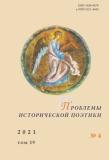«Арабески» Н. В. Гоголя: единство композиции и проблематики цикла
The “Arabesques” Cycle by N. V. Gogol: Unity of Composition and Problems
Author(s): Igor’ A. VinogradovSubject(s): Christian Theology and Religion, Russian Literature, 19th Century, Philology, Theory of Literature
Published by: Петрозаводский государственный университет
Keywords: N. V. Gogol; biography; creativity; cycle; genre; composition; author’s concept; interpretation; art; V. G. Wakenroder; historicism; patristic heritage;
Summary/Abstract: The unity of the problematics and the author’s composition principles in N. V. Gogol Arabesques (1835) are investigated. The ambiguous unity and integrity of this poetic encyclopedia manifest through the exposure of the recurring themes and motifs of the cycle, the numerous interconnections and overlaps between the articles, essays and stories included in the collection. It is established that the writer’s reflections of a religious and political nature are the consolidating source of the cycle. All eighteen works in the collection are analyzed in detail in relation to this key component. For the first time, the influence of spiritual literature — hagiographic and patristic works, the significance of the articles of “Philokalia” — a well-known collection of works on the prayer-contemplative experience of monastic life — in the early works of Gogol is examined. The spiritual aspect of the writer’s reflections on history, arts, folk art, world literature and A. S. Pushkin’s poetry is noted. Gogol’s polemic with the views of one of the founders of German romanticism, V. G. Wackenroder, is touched upon. The problems posed in the collection, such as the antagonism between old age and youth, “sensual” life and the poetry of spirituality are analyzed, depiction of the “fragmentation” of life as a distinctive feature of modernity is traced. The organic correlation of Arabesques with the previous and subsequent works of the writer is revealed, i.e., with his early poem “Ganz Kuchelgarten,” the Mirgorod cycle, Dead Souls, Theatrical tour after the presentation of a new comedy, Selected passages from correspondence with friends, etc. The author emphasizes the consistency of the writer’s creative path and the integral spiritual and moral nature of his legacy.
Journal: Проблемы исторической поэтики
- Issue Year: 19/2021
- Issue No: 4
- Page Range: 234-304
- Page Count: 71
- Language: Russian

